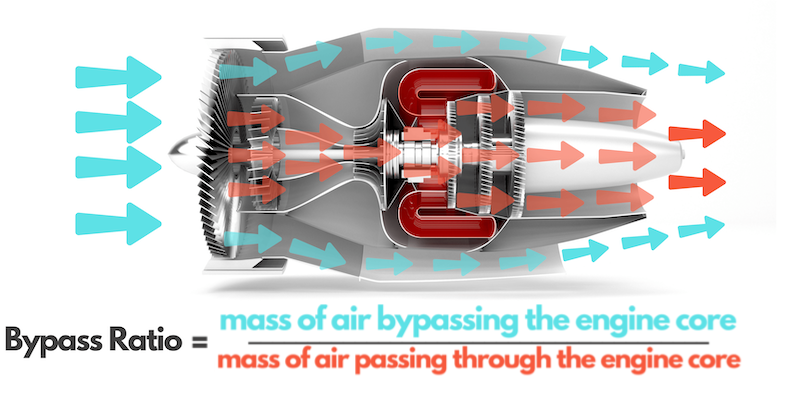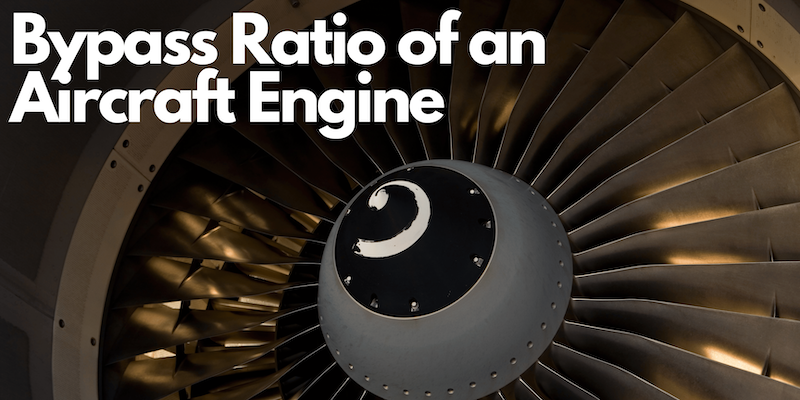Among all the aspects related to aircraft engines, one particular element captures the fascination of aviation enthusiasts, and I am no exception. The Bypass Ratio. What is the bypass ratio of an aircraft engine and how does it play a significant role in the performance and efficiency of an aircraft engine? What is the importance of a high bypass ratio in modern aviation?
The bypass ratio (BPR) of an aircraft engine is a critical factor in determining its efficiency and performance. BPR is the ratio of the mass of air bypassing the engine core (i.e., flowing around the outside of the engine) to the mass of air passing through the engine core (i.e., directly involved in combustion).

High BPR engines tend to be quieter, more fuel-efficient, and emit less carbon dioxide and nitrogen oxide. This is because much of the air is ‘bypassed’ around the engine core, resulting in a cooler and slower exhaust stream. On the other hand, low BPR engines, mostly found in military or supersonic aircraft, offer higher thrust for takeoff and higher speeds.
Understanding the bypass ratio is essential as it directly impacts the operating costs, noise levels, and environmental footprint of an aircraft. If you’ve ever wondered how airplanes manage to balance power and fuel efficiency, or why engine designs vary dramatically between different types of aircraft, you’re about to discover one of the key reasons.
Bypass ratio in military aircraft:
When it comes to defense aircraft, the bypass ratio is generally lower. The reason behind this is the need for high thrust and high-speed maneuverability, which is a vital aspect of military operations. Low BPR engines, such as those found in fighter jets, are designed to maximize power output, often at the expense of fuel efficiency.
The low bypass ratio allows these engines to reach high speeds and deliver the immediate thrust required during combat situations. The ratio of air bypassing the core to the air passing directly through it is reduced, resulting in a hot and fast exhaust stream that propels the aircraft at supersonic speeds.
However, this increased performance comes with its drawbacks such as increased noise levels and higher fuel consumption. Despite these factors, in the realm of defense aviation, the balance is tipped favorably towards power and speed over fuel efficiency.
Bypass ratio in commercial aircraft:
The importance of bypass ratio in commercial aircraft cannot be overstated. Commercial airlines continuously strive to achieve a balance between efficiency and performance, and the bypass ratio is a crucial component in this equation.
Importance of High Bypass Ratio Engines in Commercial Aviation
- Fuel Efficiency: High bypass ratio engines are significantly more fuel-efficient than their low bypass counterparts. This efficiency is of paramount importance in commercial aviation, where fuel costs represent a significant portion of an airline’s operating expenses.
- Noise Reduction: The large amount of air bypassed in high BPR engines results in a slower, cooler exhaust stream. This suppresses the noise produced by the engine, an important factor in commercial aviation due to noise pollution regulations around airports.
- Reduced Emissions: By bypassing a larger amount of air around the engine core, high BPR engines produce fewer harmful emissions. This reduction makes them a more environmentally friendly option, aligning with the aviation industry’s sustainability goals.
- Improved Takeoff Performance: High BPR engines provide greater thrust during takeoff, enhancing the aircraft’s performance and safety. This is especially beneficial for large commercial planes that require significant power to lift off the ground.
- Reliability and Durability: High BPR engines are known for their reliability and durability, which are crucial for commercial aviation, where engine failure can result in significant operational disruptions and costs.
How does a high Bypass Ratio (BPR) reduce aircraft engine noise?
The primary source of noise in aircraft engines is often the exhaust, where high-speed jets of air from the engine core mix with the slower-moving ambient air and create turbulence and subsequently noise. This is where the high-bypass ratio (BPR) engines come into play.
High BPR engines are designed so that a larger amount of air bypasses the engine core and flows around the outside. This bypassed air, which hasn’t been mixed with fuel and ignited, moves slower than the air exiting the engine core. When the faster-moving air from the engine core mixes with the cooler, slower-moving bypassed air, it reduces the speed difference between exhaust gases and the ambient air. This reduction in speed difference results in less turbulence and, therefore, less noise. This is one of the main reasons why high-bypass engines are significantly quieter than their low-bypass counterparts.
How are High Bypass Ratio Aircraft Engines more fuel efficient?
High Bypass Ratio (BPR) engines not only reduce noise but also significantly increase the efficiency of aircraft, thus consuming less fuel compared to older pure jet engines. In high BPR engines, the majority of the air propelled by the fan is bypassed around the core. This bypassed air is then used for propulsion, offering a more efficient use of the energy produced by the combustion process.
The combustion process itself in high BPR engines is more efficient because the larger mass of air passing around the engine helps to cool the engine, reducing the risk of overheating and thus maintaining the efficiency of the engine. Moreover, the slower-moving bypassed air helps to reduce the jet speed at the exhaust, resulting in less kinetic energy being wasted and more being used for propulsion.
In contrast, older pure jet engines rely solely on the jet of hot gases expelled at high speed from the rear of the engine for propulsion. However, this process is less efficient because a lot of the energy in these hot gases is wasted as they escape into the air. By making use of the bypassed air for propulsion, high BPR engines ensure a larger proportion of the engine’s energy is utilized for thrust, thus leading to increased fuel efficiency.
Evolution of bypass ratio in Commercial Aviation
Turbofan engines with their concept of bypass ratio have been a revolutionary milestone in the history of commercial aviation. The genesis of turbofan engines can be traced back to the 1960s when Rolls-Royce engineered the first high bypass turbofan engine, known as the Conway with a BPR of 0.3:1.
Although compared to modern engines this is a low BPR, it was adopted by commercial airlines for the Boeing 707 and Douglas DC-8, marking a significant leap in engine technology. To understand why aircraft manufacturers do not manufacture their own engines check here.
The turbofan era truly began in the 1970s, with the advent of Pratt & Whitney’s JT9D engine with a bypass ratio of 4.8:1. This engine, used on the iconic Boeing 747, demonstrated the advantages of high bypass ratios, notably in terms of fuel efficiency and noise reduction. This marked a turning point, as turbofans began to replace older turbojet engines throughout the aviation industry.
In the following decades, advancements in materials science, aerodynamics, and computational capabilities led to further improvements in turbofan engine design. These advancements resulted in higher bypass ratios, improved fuel efficiency, and reduced noise – characteristics embodied by the latest generation of engines like the GE9X (10:1 bypass ration) and the Rolls-Royce Trent XWB (9.6:1).
Commercial aircraft engines with the highest bypass ratios:
- General Electric GE9X: With a bypass ratio of 10:1, the GE9X is currently the commercial jet engine with one of the highest bypass ratios in the world. Used in the Boeing 777X, it’s currently the pinnacle of turbofan technology.
- Rolls-Royce Trent XWB: Powering the Airbus A350 XWB family, the Trent XWB features an impressive bypass ratio of 9.6:1, making it one of the most efficient engines in operation today.
- Pratt & Whitney PW1000G: Also known as the ‘PurePower’ series, these engines have a bypass ratio of up to 12:1, and are used across a variety of aircraft, including the Airbus A220 and A320neo family, and Embraer’s E2 series.
- CFM International LEAP: The LEAP engine, used on aircraft like the Airbus A320neo and Boeing 737 MAX, has a bypass ratio of around 9:1, contributing to its high level of efficiency.
- Rolls-Royce Trent 1000: Designed for the Boeing 787 Dreamliner, the Trent 1000 has a bypass ratio of 10:1, making it one of the most efficient turbofan engines in commercial aviation.
Some other frequently asked questions about Bypass Ratio in commercial aircraft:
Is a higher bypass ratio better?
Generally speaking, a higher bypass ratio is better for commercial aviation. It essentially means that more air is being pushed around the outside of the engine (bypassing it), rather than going through the combustion process. This results in a more fuel-efficient operation and less noise, which are key goals in modern commercial aviation.
However, as with anything in engineering, there are trade-offs. Higher bypass ratios can lead to larger engine sizes, which may not always be desirable due to weight and space constraints on the aircraft.
What is the bypass ratio of a Boeing 737?
The Boeing 737 is powered by CFM International’s LEAP-1B engines. These engines have a bypass ratio of approximately 9:1, contributing to their high efficiency and performance.
However, it’s important to note that the bypass ratio can vary slightly depending on the specific model of the 737. As with all aspects of aviation engineering, modifications and advancements are constantly being made to improve performance and efficiency.
Why do fighter jets use low bypass ratio engines?
Fighter jets typically use low bypass engines for a couple of key reasons. First, low bypass engines offer higher thrust-to-weight ratios, a crucial attribute in aerial combat where speed and maneuverability are paramount. Additionally, these engines are compact, a desirable feature given the space constraints in a fighter jet.
On the flip side, low bypass ratio engines consume more fuel and are noisier compared to high bypass ratio engines. However, in a combat environment, the trade-off for increased performance and compactness outweighs these downsides.

